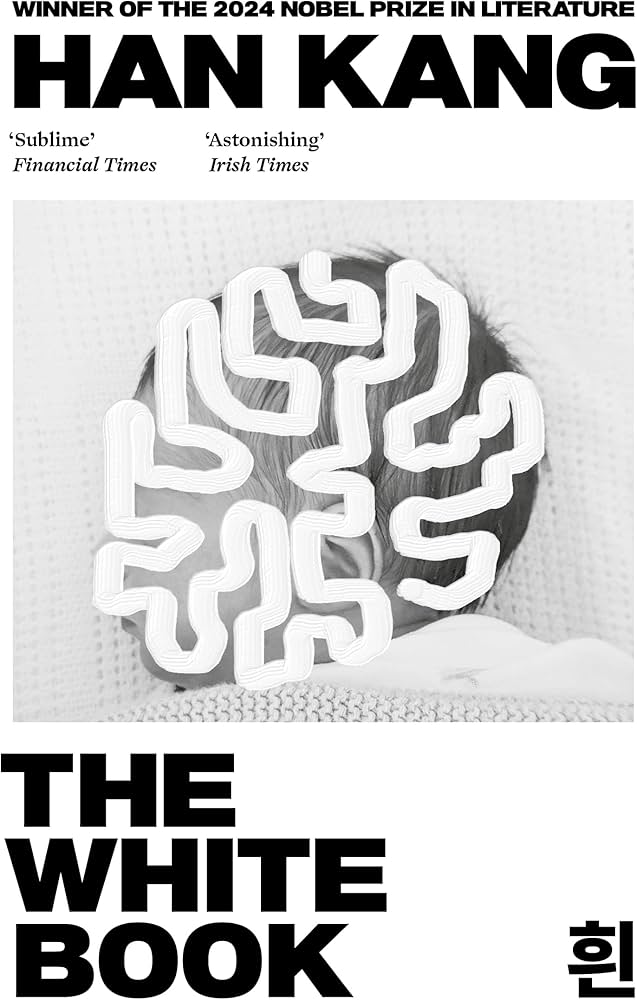Physical Address
304 North Cardinal St.
Dorchester Center, MA 02124
Physical Address
304 North Cardinal St.
Dorchester Center, MA 02124

How does it feel to see the world in shades of white? Is it a source of peace, or does it evoke an emptiness? What lingers in the silence when everything melts into whiteness—snow, blank pages, the dawn’s quiet? Does grief become lighter in this stretch, or does it settle deeper in the soul? These thoughts lingered on me when I read The White Book by Han Kang, the first Korean author to win the Nobel Prize for Literature. This psychological fiction unfolds as a tapestry of fragmented stories, each shaped by the author’s profound feelings toward white objects, all interwoven beneath the shadow of grief. Through poetic meditations, Han Kang explores themes of loss, memory, and the quiet weight of existence, using the color white as both canvas and metaphor. I was first drawn to this book by its haunting cover, which features a delicate pattern over an image of a baby. The back cover offers no summary, and the book itself lacks a table of contents. With sparse pages containing no more than twenty lines each, it’s a read that can be completed in a single day.
Throughout her works, Han Kang’s writing exhibits a melancholic, poetic quality rich with layered metaphors. In The White Book, this style shines even brighter. Its fragmented structure mirrors scattered memories pieced together through delicate, introspective prose. Each section is brief yet profound, allowing silence and whitespace to resonate just as powerfully as the words themselves. Her minimalist approach enhances the book’s meditative flow. There are no elaborate descriptions or conventional story arcs; instead, emotions seep through quiet, restrained sentences. The repetition of white objects—snow, salt, fog—creates a symbolic language, each carrying echoes of grief, absence, and remembrance. The use of second-person narration in certain passages intensifies this effect, making the reader both an observer and a participant in the author’s mourning.
This book is emotionally evocative, presenting both haunting whispers of sadness and waves of overwhelming grief. Through her sparse yet profoundly affecting writing, Han Kang transforms the color white into a canvas of loss, reflection, and quiet resilience. The White Book is divided into three sections: I, She, and All Whiteness. The first section, “I,” includes fragmented pieces titled “Door,” “Swaddling Bands,” “Newborn Gowns,” “Moon-shaped Rice Cakes,” “Fog,” “White City,” and more. Each of these white objects is tied to a singular, profound loss—the death of the author’s elder sister, who lived for only two hours. This loss deeply affected her mother, who bore not only the grief but also the lingering void left by losing a child.
The author, in turn, weaves herself into this shared grief as she journeys through life, observing and collecting white items as symbols of remembrance. The section closes with a hauntingly poignant line: “What is white, though, may yet be sullied; only white things will I give.” This encapsulates the author’s ritualistic dedication to preserving purity and memory through the color white. The second section, “She,” offers various interpretations of life and grief, emphasizing the transient nature of existence—how nothing is eternal. One passage that resonates with me is “Laughing Whitely,” which explores laughter amidst chaos. It provokes thought on whether one can manage to laugh in the face of turmoil or struggle to smile while battling inner sorrow. Life, however, moves forward, indifferent to our grief, and as fragile beings, we cling to whatever we can—love, fleeting moments, memories that anchor us in the tumult of existence.
The final section, “All Whiteness,” feels like a warm embrace—a quiet resolution to the journey of grief and remembrance. I won’t reveal more about this part since it’s best experienced firsthand. I encourage you to read it without spoilers and allow its meaning to unfold in your way. Motivated by curiosity following Han Kang’s Nobel Prize win, I’m grateful I chose to read this book. The White Book is a deeply emotional and psychological work—one that deserves to be experienced, allowing Han Kang’s fragmented memories to resonate naturally. The weight of grief is palpable, and I found myself connecting with it, understanding the profound pain of mourning. As I reflect on the themes within The White Book, several unanswered questions linger: What specific experiences or memories led Han Kang to associate the colour white with grief? How does the emotional journey in this book compare to the themes in her other works? In what ways does the second-person narration affect the reader’s connection to loss and memory? yet to be answered.
Have you read The White Book? What white object reminds you of memory or loss?